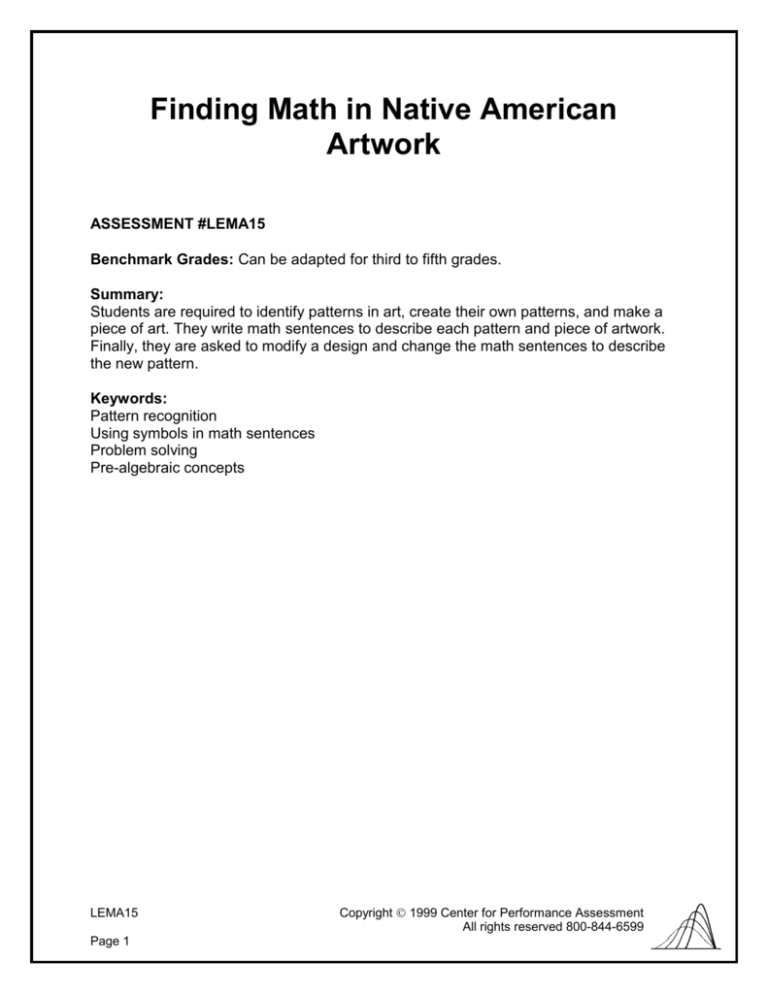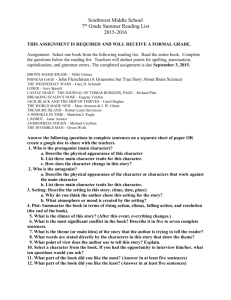
Finding Math in Native American
Artwork
ASSESSMENT #LEMA15
Benchmark Grades: Can be adapted for third to fifth grades.
Summary:
Students are required to identify patterns in art, create their own patterns, and make a
piece of art. They write math sentences to describe each pattern and piece of artwork.
Finally, they are asked to modify a design and change the math sentences to describe
the new pattern.
Keywords:
Pattern recognition
Using symbols in math sentences
Problem solving
Pre-algebraic concepts
LEMA15
Page 1
Copyright 1999 Center for Performance Assessment
All rights reserved 800-844-6599
Finding Math in Native American
Artwork
ASSESSMENT #LEMA15
Information for the Teacher
Task Description
This assessment allows students to explore pre-algebraic concepts, and to identify and
express patterns by evaluating and creating their own artwork. First, students identify
distinct patterns in Native American art. This gives the teacher an opportunity to
demonstrate how math is involved in a variety of disciplines and activities. It also
weaves math and social studies units into a meaningful context for the student.
After reviewing art and finding patterns, students describe the patterns in mathematical
sentences using symbols and numbers. They are encouraged to find more than one
way to describe the patterns using various arithmetic operations such as addition and
multiplication.
Students create their own patterns and describe them to partners in mathematical
sentences that the partner has to use in order to draw the pattern. Finally, the student
creates a neckpiece with beads or other art supplies that are available to the teacher.
The teacher has the option of providing pictures of a particular style of Native American
art (beadwork is the artwork described in the unmodified assessment), or enriching the
assessment by allowing the students to conduct research on various styles of art from
different Native American cultures. By doing this, the students decide on their own
which style and culture they wish to examine.
Required Materials
Pictures of various types of Native American art, particularly using beadwork.
Art supplies such as yarn and colored beads of various shapes.
Scoring key for the teacher
Answers will vary.
LEMA15
Page 2
Copyright 1999 Center for Performance Assessment
All rights reserved 800-844-6599
Finding Math in Native American
Artwork
Assessment Introduction: Here is what you will do...
Native Americans live in different parts of North America. Different
Native American cultures make and use different kinds of jewelry and
other pieces of art. If you look closely at Native American artwork,
you will usually see a variety of distinct designs.
In these pages, you will see how math can be found in artwork. Then
you will make your own piece of art using designs that are similar to
those in many Native American cultures.
LEMA15
Page 3
Copyright 1999 Center for Performance Assessment
All rights reserved 800-844-6599
Task 1: Native American patterns
There are many Native American styles of art. Some cultures are known
for the pottery and the rugs that they make. Others are known for creating
beautiful totem poles and canoes. Others make jewelry with beads, stones,
and jewels. This artwork has very interesting patterns in it.
For now, you will be given some pictures of artwork that has colorful beads
in it.
Look at the pictures of artwork. Look carefully and see if you can identify
a pattern within the piece. What shapes are used? What colors? Do the
small patterns make a bigger design?
Draw the patterns you see. Show as much detail as you can.
Write down the name of the Native American group that created this
piece of art and any other interesting information you wish to include.
LEMA15
Page 4
Copyright 1999 Center for Performance Assessment
All rights reserved 800-844-6599
Scoring Guide - Task 1
4
Exemplary
The criteria for a score of Proficient are successfully met.
More advanced work is completed. For example, the student chooses an
extremely detailed and difficult pattern to examine. He or she identifies and
draws smaller patterns that make up a larger design, and shows how they are
connected. Other examples include:
_____________________________________________________________________
3
Proficient
The student examines artwork and then draws the patterns in the design.
All patterns in the design are identified and drawn correctly.
2
Progressing
The student examines artwork and then draws at least one pattern in the design.
Some but not all of the patterns in the design are identified, OR
Some are not drawn correctly and need to be revised.
More work is needed.
1
Not meeting the standard(s)
At least one pattern is found but the drawing is incorrect. There is not enough
information for the student to go to the next step.
The task should be repeated.
LEMA15
Page 5
Copyright 1999 Center for Performance Assessment
All rights reserved 800-844-6599
Student Scoring Guide - Task 1
4
I checked off everything under number three.
I did an extra great job because:
____________________________________________________________
3
I looked at artwork and drew the patterns in the design.
I drew the patterns in the design correctly.
2
I found one pattern, but did not draw it correctly.
I will keep trying.
1
I did not understand what to do.
I will ask questions and try again.
LEMA15
Page 6
Copyright 1999 Center for Performance Assessment
All rights reserved 800-844-6599
Task 2: Use math to describe each pattern
Look for math in artwork. Using the artwork from Task 1, write math
sentences to describe the patterns.
For example, a pattern that looks like might be written as:
+ ++++++.
If there is more than one pattern, write math sentences for all of the
patterns.
Do small patterns make up one big one? Write a math sentence for the big
pattern, too.
LEMA15
Page 7
Copyright 1999 Center for Performance Assessment
All rights reserved 800-844-6599
Scoring Guide - Task 2
4
Exemplary
The criteria for a score of Proficient are successfully met.
More advanced work is completed. For example, the student writes sentences
for the patterns and also for the larger design the patterns make. Other
examples include:
_____________________________________________________________________
3
Proficient
The student writes math sentences that accurately describe every pattern in the
design.
The student writes at least one math sentence for each pattern in the design.
Correct symbols are used.
2
Progressing
The student writes math sentences that describe some, but not all of the patterns in
the design.
The student writes at least one math sentence for the patterns he or she identifies,
OR
The sentences are based on the patterns, but are not entirely clear or are incorrect.
More work is needed.
1
Not meeting the standard(s)
The math sentences don’t describe the patterns that are identified in the artwork.
The task should be repeated.
LEMA15
Page 8
Copyright 1999 Center for Performance Assessment
All rights reserved 800-844-6599
Student Scoring Guide - Task 2
4
I checked off everything under number three.
I did an extra great job because:
____________________________________________________________
3
I wrote math sentences that tell about the design.
I used correct math symbols in the sentences.
2
I did not use the correct symbols to make math sentences.
I will keep trying.
1
I didn’t understand what to do.
I will ask questions and try again.
LEMA15
Page 9
Copyright 1999 Center for Performance Assessment
All rights reserved 800-844-6599
Task 3: Create your own patterns
Think of interesting patterns that you would like to draw or create. Can they
be written as math sentences?
Make up and draw at least three of your own patterns. Make them as
detailed as you can.
Describe your patterns using math sentences, just as you did in Task 2.
Give your math sentences to a partner and see if he or she can solve
the math sentences in order to draw your patterns.
LEMA15
Page 10
Copyright 1999 Center for Performance Assessment
All rights reserved 800-844-6599
Scoring Guide - Task 3
4
Exemplary
The criteria for a score of Proficient are successfully met.
The student completes more advanced work. For example, the student
connects all of the patterns and writes sentences that describe the larger
design that is made. Other examples include:
_____________________________________________________________________
3
2
1
Proficient
The student creates at least three patterns. Each pattern is detailed and clearly
presented.
Each of the patterns is described in at least one math sentence. The math
sentences are clear enough to be followed to draw the patterns.
The math sentences are all correct.
Progressing
The student creates one pattern.
The pattern is described in one math sentence.
The math sentence is not clear enough to be followed to draw the pattern or is
incorrect.
The task needs more work.
Not meeting the standard(s)
One pattern is created, but no math sentence to describe it.
The task should be repeated.
LEMA15
Page 11
Copyright 1999 Center for Performance Assessment
All rights reserved 800-844-6599
Student Scoring Guide - Task 3
4
I checked off everything under number three.
I did an extra great job because:
____________________________________________________________
3
I created three (or more) patterns.
My patterns are described in at least one math sentence.
I shared them with a partner.
The math sentences are all correct.
2
I created one pattern.
My math sentences are not correct.
I will keep trying on my patterns and sentences.
1
I did not understand what to do.
I will ask questions and try again.
LEMA15
Page 12
Copyright 1999 Center for Performance Assessment
All rights reserved 800-844-6599
Task 4: Turn your pattern into art
Now it is time to create your pattern. You are going to be making the
pattern out of beads and yarn or other art supplies.
Choose at least one of the patterns you created in Task 3. Use this
pattern to create a neckpiece that is 16 inches long.
String the beads to match your pattern.
Write a math sentence for this piece of artwork.
LEMA15
Page 13
Copyright 1999 Center for Performance Assessment
All rights reserved 800-844-6599
Scoring Guide - Task 4
4
Exemplary
The criteria for a score of Proficient are successfully met.
The student completes more work. For example, he or she creates additional
pieces that vary in length, but have the same pattern. Other examples include:
_____________________________________________________________________
3
2
1
Proficient
The student chooses one pattern.
A neckpiece 16 inches long is made.
The student represents the pattern with a math sentence.
Progressing
The student chooses one pattern.
A neckpiece is created, but it does not match the pattern or the requirements of the
task.
Some revision is needed.
Not meeting the standard(s)
The student chooses a pattern, but no number sentences are attempted or no
neckpiece is created.
The task should be repeated.
LEMA15
Page 14
Copyright 1999 Center for Performance Assessment
All rights reserved 800-844-6599
Student Scoring Guide - Task 4
4
I checked off everything under number three.
I did an extra great job because:
____________________________________________________________
3
I chose one pattern.
I made a neckpiece 16 inches long.
I wrote a math sentence that matches the design.
My math sentence is correct.
2
My neckpiece does not match my pattern, or there is another problem.
I will keep trying.
1
I did not understand what to do.
I will ask questions and try again.
LEMA15
Page 15
Copyright 1999 Center for Performance Assessment
All rights reserved 800-844-6599










